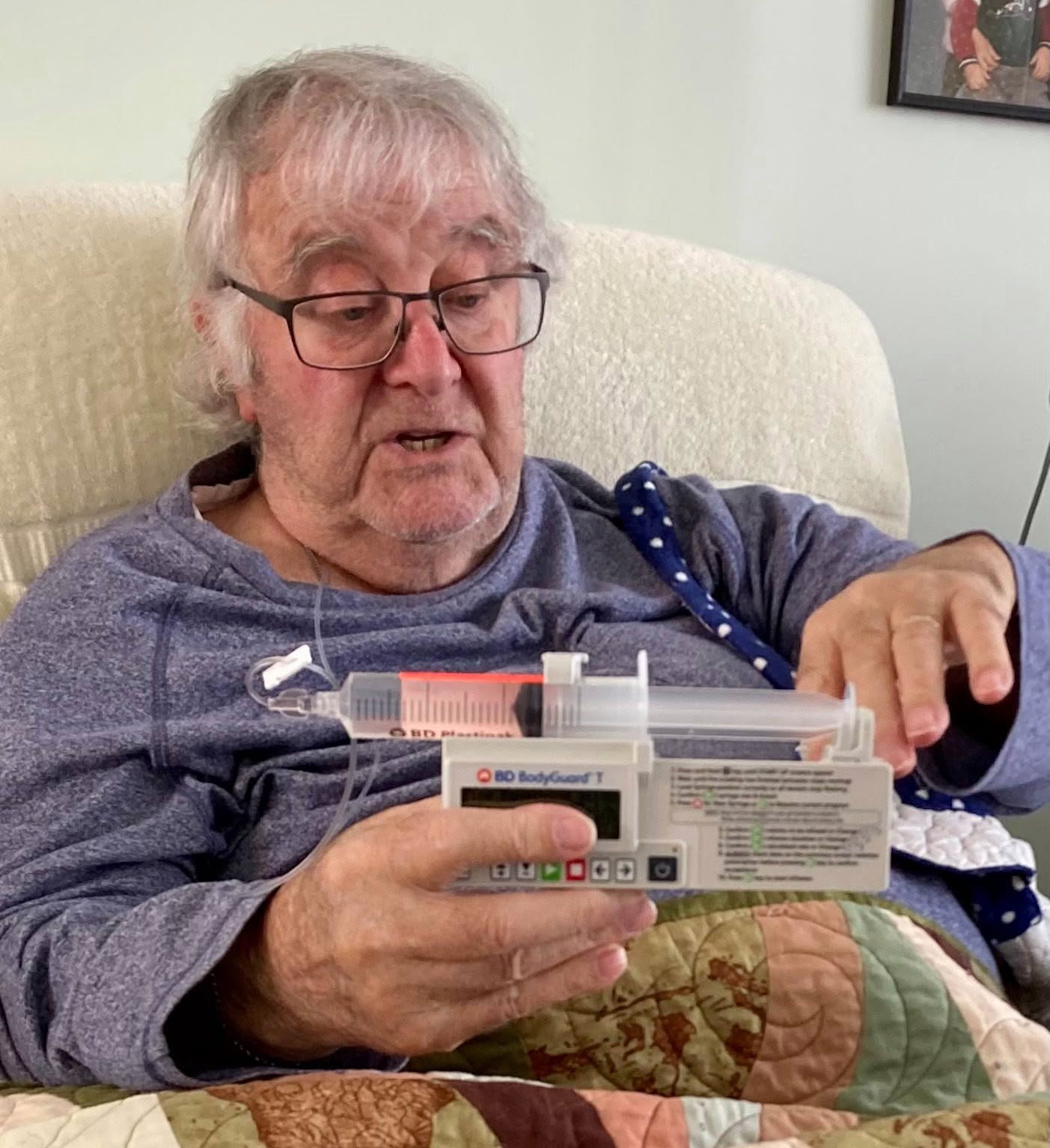When printing and packaging engineer John Bradley couldn’t start his lawn mower, he just thought he needed to get a bit fitter. There’d been a lot of family and business stress; his wife wasn’t well, and sometimes you just had a bad day.
He pulled the mower cord again, and his arms and chest suddenly began to hurt.
He went inside, and wife Jan told him he didn’t look too good. He didn’t feel too good, either, but reasoned a wee rest would probably fix things.
Next day, still hurting, he went to his doctor.
He nearly had heart failure when he was told he was in heart failure. Immediate medication stopped the pain, but within days John, of Feilding, was at the Wakefield Clinic in Wellington, having a heart bypass.
That was about 30 years ago, and now John is under Arohanui Hospice palliative care, his heart still gamely beating, but telling John all the time that it’s hard yards and to make the most of what it can still give him.
“It’s like having an iron bar across your chest. Aching arms and wrists, your gullet’s tight, it’s hard to breathe and you’re tired. Exhausted.”
He and his second wife, Judith, can’t praise the Hospice enough. When John’s specialist told him earlier this year that he was right at the end of heart failure, and more surgery was out of the question, he knew had to get his affairs in order.
One of the things that helped was courses for carers by the Hospice, which Judith attended. They covered essentials such as equipment, medication use, dealing with grief, and one particularly helpful session was all about legalities. Using this information, John and Judith got Enduring Powers of Attorney sorted, fixed up their bank accounts and made sure their wills and other necessary legal documents were all in order. They’ve planned his funeral and John and his family and friends have written the story of John’s life, which has collected important family stories and photographs. He’s called it A Satisfactory Life, and it typifies John’s values.
“If it was made by man, it can be fixed by men, and we’re the men to do it,” John says. And like Winston Churchill, John “never, never, never gives up”.
The Hospice’s many other services for patients undergoing palliative care reinforces this attitude. John gets his medication through a nifty little pump which slowly delivers it under his skin, a device that’s won his engineer’s admiration for elegant efficiency. It lives in a little bag that lives over John’s shoulder. The district nurses come every second day to change it.
Arohanui Hospice arranged equipment through Palmerston North Hospital to help John, and ease Judith’s caring tasks. A hospital bed, a monkey bar to help John pull himself up, tables on wheels and bathroom aids are all there, with more options available when John needs them.
Judith’s devised a special chart for John to record what his body is doing, every day. Fluid intake and output is especially important for his condition, and it covers other categories like his pain levels and what medication he’s taken. Pain makes detail recall difficult, so accurate records are vital.
And when things get difficult, the Hospice’s 24-hour telephone help line is there for them. Afterhours, they can ring and get advice, and the help line staff keep in touch until the issue is either resolved, or an ambulance is dispatched.
“Everything got so simple for us once the Hospice took us on,” John said. “It’s all organised now… we can just enjoy the time we have left. They’re a fantastic outfit. Everyone’s so helpful and cheerful and nice, and they get what’s happening.”
Getting the end of his life in order was a natural thing for John to do, because as an engineer, his life has been fixing problems, thinking right round and through ideas to invent machinery and methods.
He apprenticed as a fitter and turner at Berry’s Engineering of Palmerston North in the 1960s, and that laid the foundation for creating solutions. Worked a lot of jobs once he’d qualified, with one life-changing stint at Satterthwaites learning the ins and outs of being a printing engineer.
“They gave me a car to get round the various plants. It was this little Toyota Corolla and I had this bloody great toolbox. Went all round the country in it, they had the Heidelberg franchise, that was the Rolls Royce of printing machines.”
He earned the reputation as a problem solver for the printing and packaging industry. He’s proud to have been the brains behind developing machinery to streamline production and handling of New Zealand Qualification Agency exam documents. It took several years and collaboration with a company in Finland, but it came together and worked and John was invited to the commissioning celebration on The Terrace in Wellington.
All the flash suits weren’t John’s style. He was trying to hide in a corner when somebody asked him what mathematical formulae he’d used to create the machinery. It was a bit of a moment for John, because he was the kid who’d left school at age 15 to start his apprenticeship, pretty much to dodge sitting the old School Certificate examinations. He didn’t fancy learning fancy maths, so it was spatial recognition, broad conceptual experience and understanding and an inquiring mind that were his tools. He’s been that way all his life; he’d been a paper boy and a scout and was the kid who was good with his hands. Weekends always saw a project on the go, building something or other for himself or the family or friends. He spent a lot of time helping with the Victoria Esplanade’s miniature railway, building the first engine.
His experience, and the “bloody great toolbox,” led John to invent solutions for many other companies. His company, Graphpak Services (1981 to 2000), saw him specialise in creating hybrid machines specific to each client’s needs. “I’ve always been a bit of an inventor.”
Heart pain of another type culminated in 2009, when wife Jan died after a 10-year illness battling Parkinson’s Disease. Breast cancer took her; her cancer symptoms were masked by the Parkinson’s and complicated by anxiety and other mental health issues, so her end was very quick.
John grieved for four years, then his daughters Kelly and Tina lined him up and told him he should think about meeting somebody else. But how did you meet somebody else, when you were aged 60-something? He had searing memories of rescuing his daughters from a nightclub when they were teens, blokes hitting on them, and he wasn’t into that scene.
Engineering efficiency helped again. John got himself onto a dating site for older folk, and after initial difficulties dodging old ducks who wanted to know if he had a yacht, he found Judith, a very special lady living in Nelson. They went slowly; discovered they both loved craft and making things, and shared similar backgrounds. Eventually they married and spent four wonderful years travelling New Zealand in Primrose, a bus converted to a motorhome. Partially converted, when they set out; John and Judith got it right for them on the journey. They sold Judith’s hand-made jewellery on their trip.
They settled back to Feilding, living in a Manawatu Community Trust flat that forms part of a community of friendly neighbours, who keep an eye out for each other. John says it’s just like the old days, when there was a sense of belonging.
“I’m truly proud to have my story featured because I hope it will help our wonderful Hospice,” he said.


